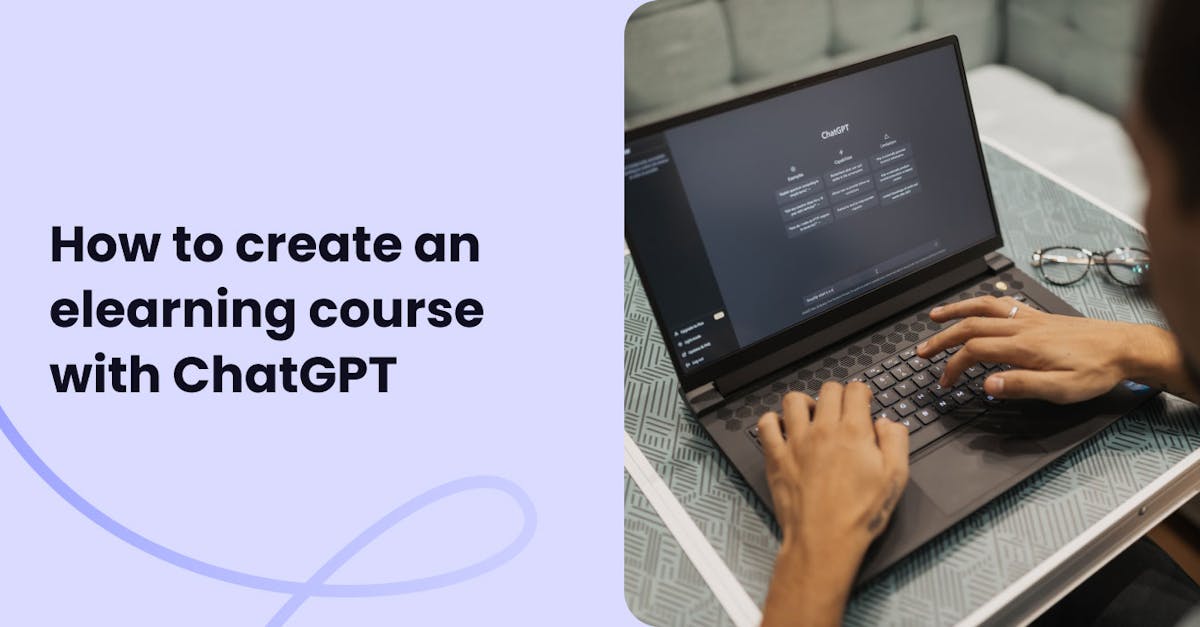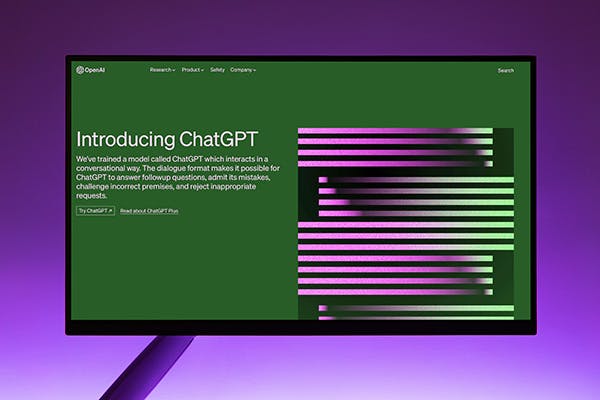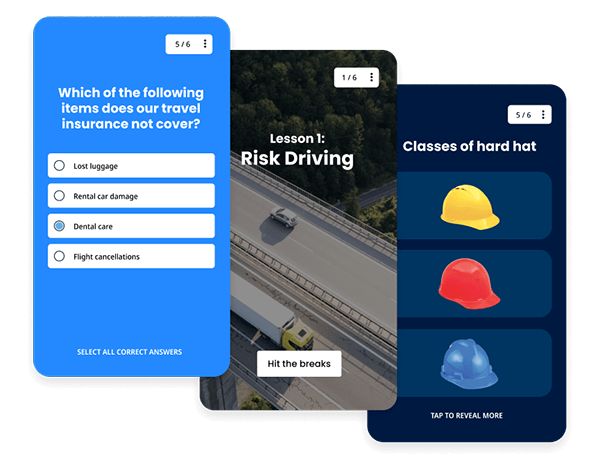How to create an elearning course with ChatGPT app

With the continuous growth of technologies, it's no surprise that we’re now seeing all kinds of tools that significantly speed up the course creation process. One of these innovations is ChatGPT. This powerful AI chatbot and language model can revolutionize the way we create learning content.
Aside from helping you break through creative blocks and limitations, AI streamlines the course building process. This means you can now whip up an online course in record time! In this article, we’ll delve into ChatGPT, its benefits, and how you can use the tool to create an elearning course.
What is ChatGPT?
Developed by the company, OpenAI, ChatGPT is a type of artificial intelligence known as a chatbot. It’s a natural language processing tool that lets you have human-like conversations, assisting you with different types of tasks, including article or essay writing, coding, email composition, scheduling, editing, and so much more.

To access the platform, all you need to do is go to chat.openai.com and create an account. Once you’ve signed in, you can start chatting and sending questions or commands, also known as prompts.
Benefits of using ChatGPT for course creation
One of the ways you can take advantage of ChatGPT is by using it to create education apps or elearning courses. It’s really useful in that it can help you quickly brainstorm topic ideas, create course outlines, and edit content. To break it down further, here are some of its other benefits:
- Efficient - AI is a game-changer for learning designers, course creators, and instructors. It comes up with answers to questions and commands in just seconds, making course creation so much easier and faster. Instead of getting stuck in endless brainstorming sessions that eat up precious time, now you can whip up awesome and captivating content ideas in just a few minutes.
- Works as a virtual assistant - If you want to free up your time for other tasks, you can use the tool as a virtual assistant that can help you with tasks like creating outlines, and scripts, and even coming up with assessment questions.
- Cost-effective - Instead of hiring employees to create courses, you can save money by using ChatGPT as a virtual assistant instead. And because ChatGPT has a free tier, you won’t need to shell out money to take advantage of its features.
- Empowers trainers - When you bring AI into the picture, you become more empowered to create engaging and dynamic content. You can have conversations with the language model, ask all sorts of questions, seek explanations, and get instant feedback about your lessons.
Challenges of using ChatGPT for course creation
Similar to other new technologies, ChatGPT also has its fair share of limitations. Here are some examples that you might encounter when working with the tool:
- Reduced accuracy - Sometimes, ChatGPT can give you info that's not quite accurate or even incomplete. This can cause some serious misunderstandings and confusion for both students and teachers. So, it's important to keep in mind that while ChatGPT is useful, you need to back up its data with proper research.
- Potentially biased datasets - If the dataset that ChatGPT relies on is biased, it's important to know that its responses can end up being biased too, which could unintentionally reinforce certain stereotypes in the course content.
- Lack of creativity and context - Although AI is great for automating stuff and making processes easier, it might not be as creative as you when it comes to teaching. You see, without that human touch, AI-generated courses can sometimes fall a bit flat. Also, they might lack proper context and might not be as engaging or innovative, especially when it comes to more complex elearning concepts.
- Over-dependence on AI - Relying too much on AI-generated content can have its own downsides. It might lead to reduced critical thinking, problem-solving, and creativity in course creation. Picture this: if you're always turning to ChatGPT for answers without really thinking things through, you might miss out on the chance to let your creative juices flow.
Step-by-step course creation process with ChatGPT
If you want to get started on creating elearning courses that your team will absolutely adore, here are five simple steps. Don’t worry, you don't need fancy tools or design skills. All you need is internet access and a ChatGPT account, and you're all set to rock and roll!
Step 1: Finalize your target audience, course topic, and learning objectives
Three important factors you’ll need to determine before being able to send a course creation prompt on ChatGPT are your target audience, course topic, and learning goals. First of all, it's definitely a smart move to give ChatGPTmore context about your audience, like figuring out whether you're dealing with fresh faces in your office, the folks working in your retail store or your hardworking maintenance crew.

Then, you’ll also have to finalize what topic you’re going to be focusing on and what you want your learners to get out of the training. The more specific you get, the more detailed the course outlines can be.
Step 2: Create a course outline using written prompts
A prompt is basically a written guideline that gives you an idea or starting point for different types of writing ideas. What’s awesome about prompts is that they're super flexible and can totally be customized to suit your specific needs. You can easily tweak them by adding or removing criteria, changing the language, and playing around with the formatting. It's all about making it work for you.

Once you have your audience, topic, and objectives, you can easily ask ChatGPT to create an outline for you. Here are some sample prompts:
- Create a course outline on [subject] for [audience] that satisfies [learning objectives]
- Develop a detailed outline for a course titled: [course topic] aimed at [target audience]. The learning objectives of this course are [learning objectives 1, 2, & 3]
- Explain [topic] for [audience] so that they can [learning objective]
Step 3: Create content for authoring tools
Once you have your outline, it becomes easier to research and add the bulk content of the training material. You can also spice things up by throwing in some instructional strategies or suitable learning materials to guide ChatGPT. If you’re thinking of creating a microlearning course, make sure to be specific. To achieve this, you can input a prompt like “format the text for a microlesson and add bullet points.”

Step 4: Refine and review the learning content
When it comes to explaining tricky stuff, you can use prompts like "Explain this lesson like I’m a 10-year old." This can help you break down more specific and complex subtopics into super easy and fun explanations that even a kid can understand.
Here's another cool thing you can do if you want ideas on how to make your course more exciting and interactive. Simply add a prompt that says "suggest course engagement methods” and watch ChatGPT open the floor for awesome suggestions to make each lesson a whole lot more fun.
You can even ask ChatGPT to generate assessments or quizzes for you based on your course content. Then, once you have all your course detail, make sure to review and fact-check all your course data and back it up with research.
Step 5: Design and publish the elearning content
After the final review, all you have to do is put everything together using a presentation tool, video maker, or course authoring tool—whatever works best for you and your learners. If you’re looking for a quick and easy way to build your course, authoring tools by elearning development companies are the best option.
EdApp is a great example of this. Through its Creator Tool, you can choose from its collection of elearning templates and drag and drop your text, images, or videos, apply branding, and hit publish. The tool even allows you to add games and quizzes to make the course more interactive. All you have to do is copy your generated assessment questions from ChatGPT and into the built-in quiz maker.

Even better, you can now take advantage of EdApp’s newest feature: AI Create. With this tool, you can skip some of these steps and jump right into making your course content. It takes your language commands or text prompts and turns them into interactive microlessons in seconds.

And guess what? You can use it for free! Since it's super easy to use, you no longer have to worry about getting stuck on the course creation process.
Try EdApp’s AI Create at no cost and generate brilliant elearning courses in no time!
Subscribe to our blog newsletter
Author
Hannah Malmstrom
Hannah is an eLearning writer who dedicates her time to creating in-depth content about EdApp, a multi-award-winning mobile LMS that has pioneered one of the most progressive microlearning solutions on the market. She brings years of writing experience in the online software industry to her current role in the eLearning sphere. When she's not writing, you can find her catching up on new anime series or re-reading her favorite novels.
